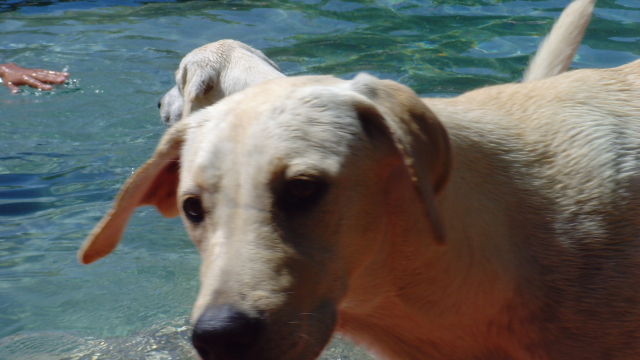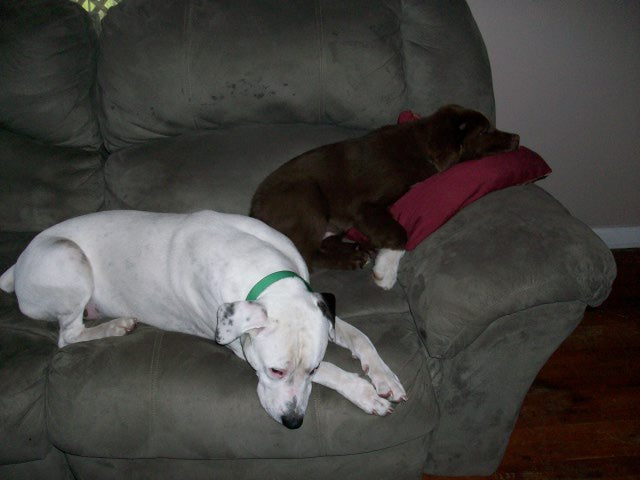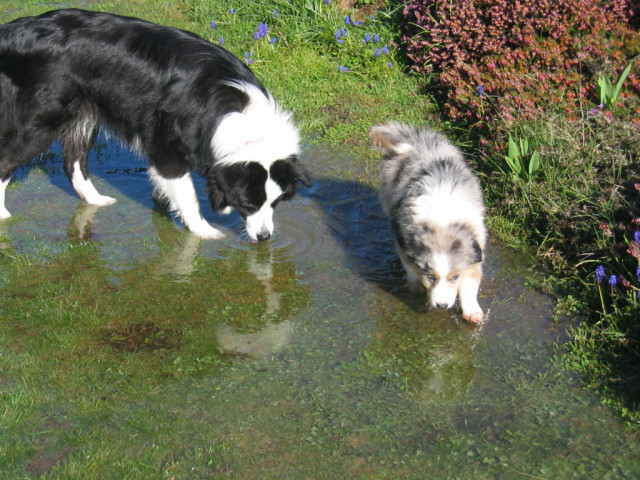QuestionDear Jill
I hope i'm writing to the right person concerning my american staffordshirer terrier. She is about 8 months now and has this constant urge to chew bricks and eat rocks. She barks at them for hours on end and gets agressive when I want to get them away from her. I fear that her teeth will break and she has thrown up rocks recently. It's a disaster.
What do you suggest I do?
Kind regards
Charlotte
AnswerYour dog appears to have developed an OCD behavior which may have begun as a result of scenting/seeing something near rocks or bricks and has now generalized to anything resembling either the rock, or the brick. This is a potentially life threatening behavior, since swallowed rocks can kill a dog very quickly. You must first bring this behavior to a veterinarian who can give her a basic neurological exam, in the event (not likely, but you never know) there is some low level seizure disorder developing (although it's quite difficult to diagnose such a disorder, even with sophisticated tests.) Most likely her basic neurological test will show nothing, but the veterinarian can then prescribe a medication that will calm her to the extent that you can then initiate behavior modification and training.
You need positive reinforcement training: go to ClickerTraining.com and do what's necessary to equip yourself. Using positive reinforcement, begin slowly (one behavior at a time) to teach this dog obedience "tricks" (that's really all it is) so she can work for reward. Begin with the easiest, "sit", and once she has obtained a 100% reliable response to this command, begin making her sit for all interaction with you (being petted, played with, fed, taken in/out). Once she has begun this regimen (and keep it in place for a few months), begin a "take it/leave it" training with a soft toy she only sees during this training. Offer the toy (after making her "sit") with a "take it" command, interact with her briefly and then totally STOP moving or interacting and wait for her to let go. The MOMENT she lets go, say "leave it", then praise her and ask her to 'sit" and start over. Repeat this two or three times a day for very short intervals until she has obtained a strong "leave it" response. Be sure to praise her every time and you can even use a small treat WHILE saying "leave it" (NOT in exchange for the toy, this is very important.) This will promote you psychologically, as will the positive reinforcement training, and develop a method you can use (the dog will have a conditioned response and should willingly relinquish anything) to disrupt her activity with rocks/bricks. Meanwhile, you cannot allow her to further interact with these objects. Take her out on leash (do not allow her to roam freely in your yard) and observe her closely. The moment you perceive she locks onto an object (rock or brick), redirect her with the play object you are using in your "take it/leave it" routine. Reward her LACK of attention to the brick/rock; be vigilant about further interaction she may attempt with those objects. Booby trapping such an object is one option but this doesn't necessarily work as the dog might attribute the startle response to something other than the object (such as a bird flying over, etc.) Dogs also develop response perseverance, which means they will return to a behavior (even if it is self punishing). As troublesome as this odd attention is, more troublesome still is the dog's response to your attempt to remove these objects. At 8 months of age, your dog should not be demonstrating any form of aggression; I can only guess that your concern and concomitant heightened adrenaline may have frightened her and she does not associate her possession of the rock with your condition. This may or may not have become an attention getting behavior. I can't see that from here. You may require the help of a certified applied animal behaviorist (NOT A DOG TRAINER!) Ask the veterinarian if s/he can refer one or call the veterinary school in your geographical area for referral.

 Psychological trauma
Question
Izzy
I recently took my 1 year old dog to a fr
Psychological trauma
Question
Izzy
I recently took my 1 year old dog to a fr
 American Bulldog aggression
Question
Buddy and Rez
I have a 2 year old Ameri
American Bulldog aggression
Question
Buddy and Rez
I have a 2 year old Ameri
 Dog light and shadow chasing
Question
Jenni
My 3 year old Cavalier King Charles Span
Dog light and shadow chasing
Question
Jenni
My 3 year old Cavalier King Charles Span
 Post bladder surgery potty training for INDOORS!
QuestionTiki
QUESTION: Dear Dr. Connor,
My 10 ye
Post bladder surgery potty training for INDOORS!
QuestionTiki
QUESTION: Dear Dr. Connor,
My 10 ye
 Dog in Heat?
QuestionLily and Jorge
QUESTION: Hello,
We have
Dog in Heat?
QuestionLily and Jorge
QUESTION: Hello,
We have